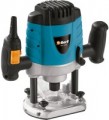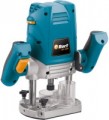Power
The total power of the router, more precisely, the engine installed in it. The
higher this indicator, the more productive the device is, the better it copes with complex work, the more force on the cutter (torque) it provides during operation, and the greater the spindle speed can be (although a powerful tool is not necessarily high-speed). On the other hand, high power significantly affects the dimensions, weight and price of the tool, plus power consumption and network load increase accordingly. In addition, high torque in some cases (for example, with delicate processing) is frankly undesirable. Therefore, a tool should be chosen according to this parameter, taking into account the real needs and the specifics of the planned work.
There are three main categories of milling cutters in terms of power: light (up to 700 W), designed mainly for simple household work; medium (up to 1500 W), able to cope not only with domestic, but also with most professional tasks; and heavy (1500 W or more), used in cases where high power is critical. However, this gradation is true only for routers (see "Type"), other varieties have their own specifics: for example, lamellar models, in principle, do not need high power.
Max. collet diameter
The largest collet size that the router can use.
A collet is a special type of fastening used, in particular, for installing working nozzles in milling cutters. For proper installation, the size of the collet must match the size of the cutter shank. Modern cutter shanks and collets for them have standard sizes - 6, 8 or 12 mm. The larger the size, the larger the cutter itself, the more powerful the tool and the more difficult the work for which it is intended.
As a rule, the maximum size of the collet is the size of the fixture that is standardly installed in the router. Thinner cutters can be mounted using special adapters (however, care must be taken, as such a nozzle may not be designed for the increased power characteristic of tools with a large collet).
6mm collets are found predominantly in light routers (see "Power"),
8mm mounts are found in most intermediate and professional level tools, and
12mm collets are found in the most powerful and heavy models.
Stroke
The distance by which the height of the cutter can change relative to the support platform of the router, in other words, to what depth the working nozzle can be lowered relative to the upper position. This parameter is used for vertical and edge models (see "Type"); however, edge routers with height adjustment are very rare. In fact, the amount of travel not only describes the maximum working depth provided by the tool, but also indicates the presence of depth adjustment; for models without such adjustment, this parameter is not indicated at all.
As for specific numbers, for simple household work, a stroke of 25–30 mm is considered quite sufficient, and in a more serious tool, values of 70–80 mm can be found.
Functions
—
Soft start. The presence of a soft start engine in the design of the milling cutter. A feature of most modern electric motors is that when connected to the network directly, without control circuits, at the time of start-up, there is a sharp jump in current through the motor. This, on the one hand, creates voltage fluctuations in the mains (which can “knock out” fuses or become fatal for some devices operating nearby), on the other hand, it leads to a sharp jerk of the tool, due to which it can be released from hands (and this cause damage to surrounding objects and even injury). This function also limits the current at the moment of starting the motor. Due to this, the speed increases smoothly, without jerking the tool, and the power grid is not subjected to excessive overloads.
—
Adjustment of frequency of rotation. The presence of a speed controller in the design of the milling cutter. This function allows you to change the spindle speed, adjusting it to different types of work — for example, to effectively cut hard material, you may need a high speed, and with soft woods, you can work at low speeds. Tools with speed control will be useful especially for those who have to deal with a wide variety of materials. In this case, the range of such adjustment may be different.
—
Microlift. The presence in the design of the router of a system for fine-tuning
...the depth with an accuracy of 0.1 mm. The standard setting with the limit pin is very coarse, as the errors are quite large. The microlift is used where it is important to set the depth very accurately. It is implemented mainly by means of a threaded connection that limits the vertical downward movement, or is completely integrated into the vertical travel design, where unlocking is not needed to make the necessary adjustments.
— Backlight. The presence of a lighting system in the design of the router — in fact, an ordinary flashlight that facilitates work in dimly lit places. The need for backlighting may arise even in daylight or bright artificial lighting — the place of work is quite often in the shade (for example, from the head of the operator himself).
— Maintain momentum. The presence in the design of the milling cutter of a system that automatically adjusts the engine operation mode depending on the load on the working nozzle — in such a way that the rotational speed remains constant, does not fall under load and does not increase at idle. Thanks to this adjustment, a constant quality of processing is ensured, practically independent of the pressure on the nozzle, wear of the nozzle and the tool itself is reduced, as well as overall energy consumption.
